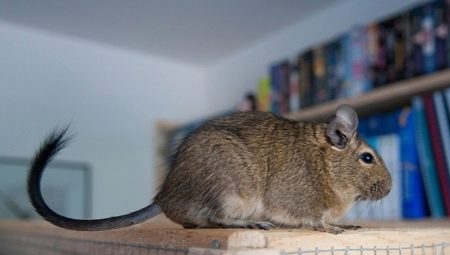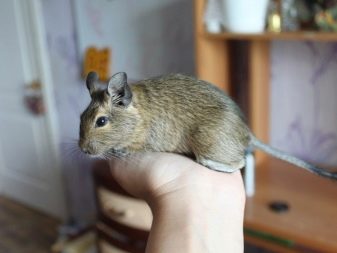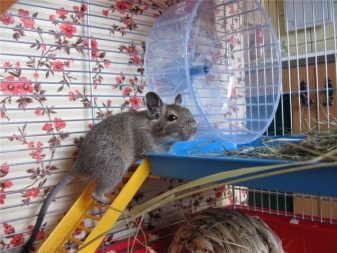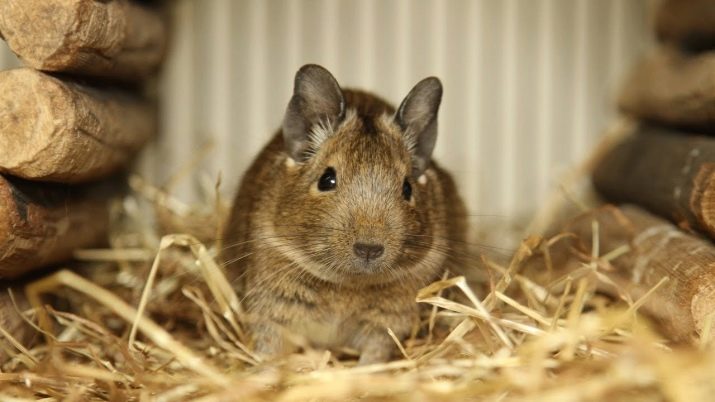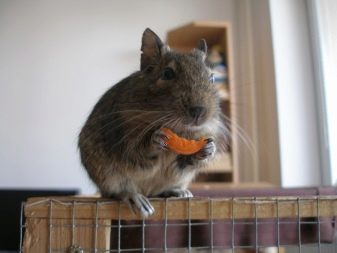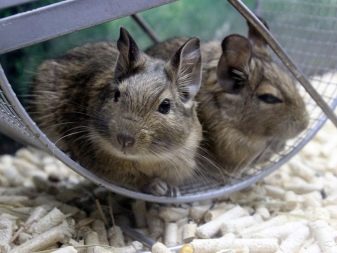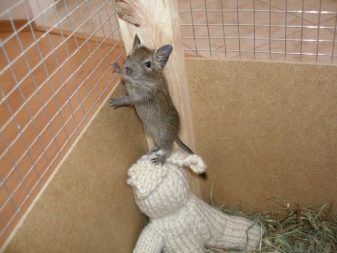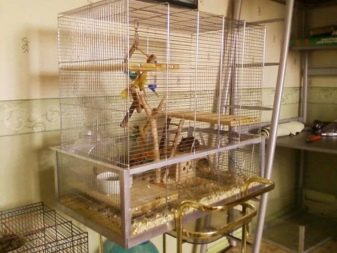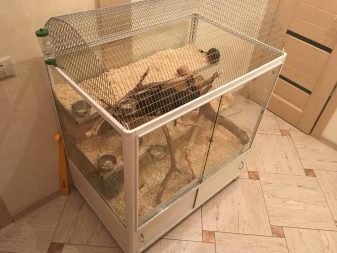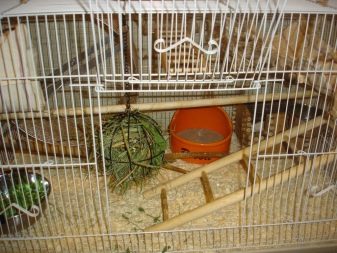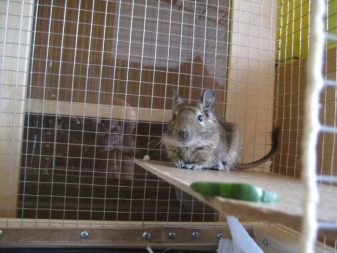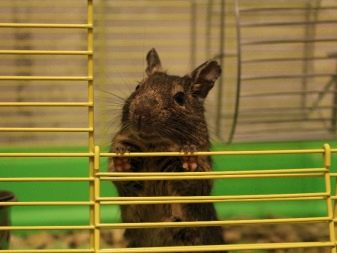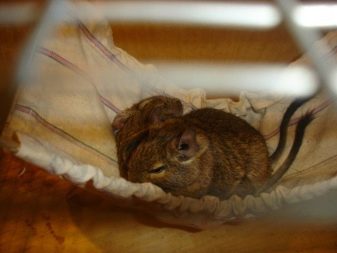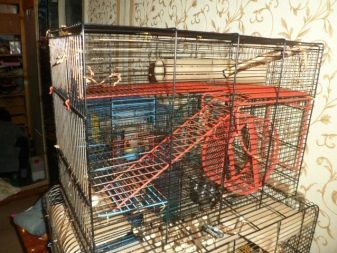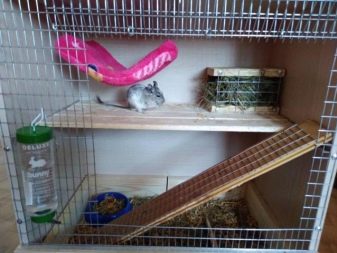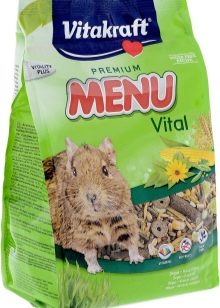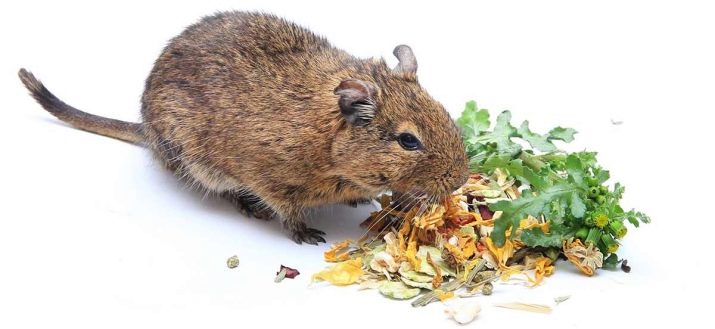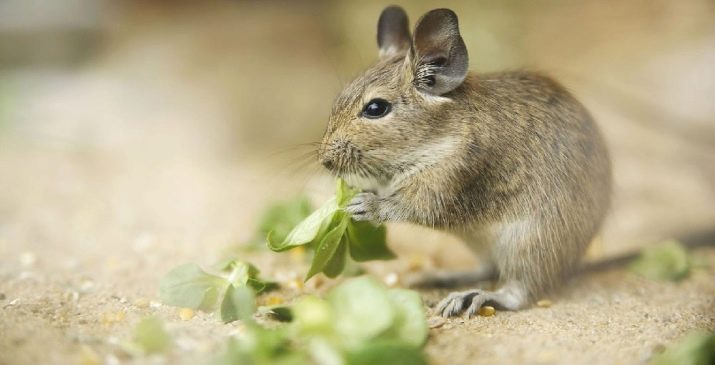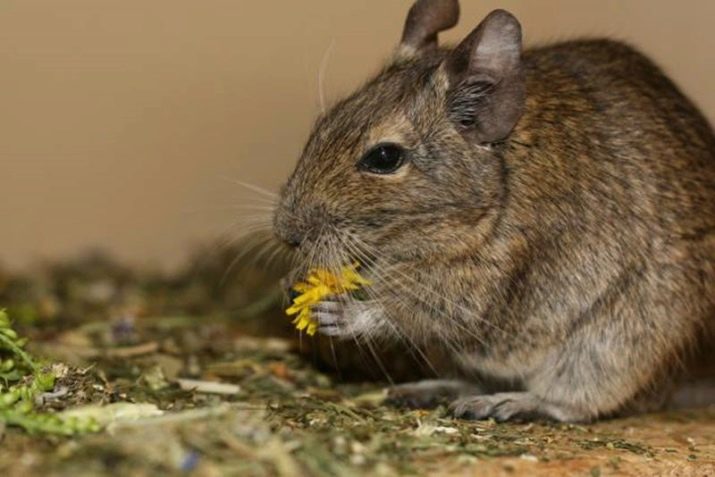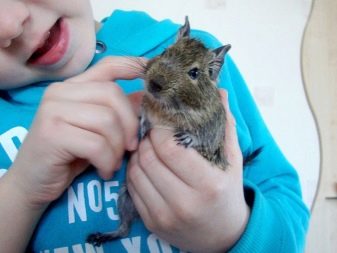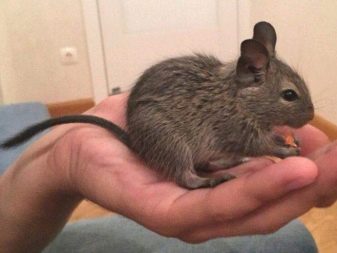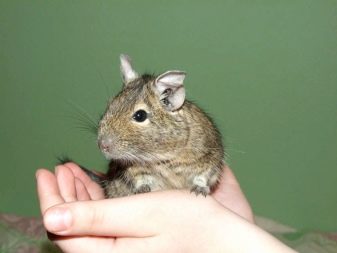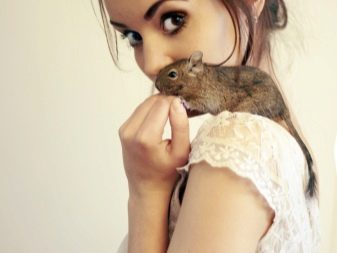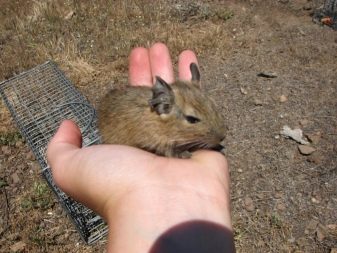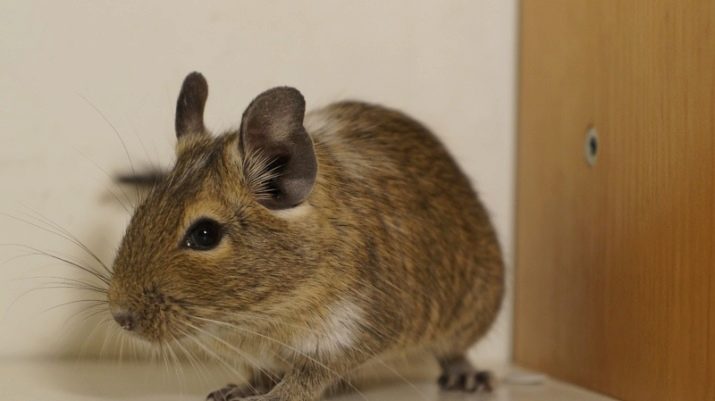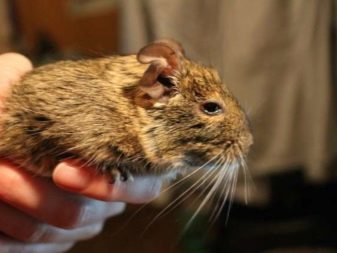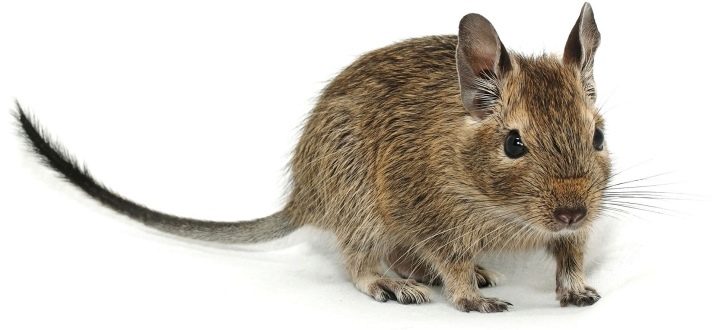Getting exotic animals is quite difficult. But you can avoid many problems if you study all the features in advance. And the very first question that needs to be answered is whether it is necessary to start the same Chilean squirrel or not.
Pros and cons of the content
The Chilean squirrel degu is a very sweet and gentle creature. Their relative rarity in domestic life makes animals only more attractive. Buying degu, you can stand out among family and friends. Probably, some people even decide to imitate the breeders.
The Chilean squirrel is not too big, it is inferior in size to the chinchilla.
Therefore, there will not be much room for degu. The amount of feed needed for this animal is small - a maximum of 0.05 kg per day. And even there is no need to buy branded compositions. Excellent feed mixture is easily prepared with your own hands with a minimum of costs. Treats can also be done without help.
Feed the degu must be exactly twice a day. At the same time - as with the care in general - not too much effort is expended. A healthy animal does not emit unpleasant or even just foreign smells. Therefore, normally it will not cause inconvenience. And if some strange odors appear, you can quickly react and cure your pet with the help of a veterinarian.
Cell cleaning should occur 1 time in 7 days, which allows you to save power and plan your care. Degus has a good immunity, but we must bear in mind that this does not apply to colored individuals. Observing the life of a Chilean squirrel is a pleasure. To train her is pretty easy. But it is important to take into account possible problems:
- the lack of readiness of most veterinarians to treat degu;
- neat little animal throws dirt out of the cage;
- Chilean protein continuously shows activity and noise;
- she will have to pay a lot of attention;
- Degu is rather shy, any extraneous sound can harm him.
How many individuals are recommended to keep together?
The Chilean squirrel must communicate with individuals of its own species. With a single content, she starts to get bored and make noise, as if calling for someone. The owners will have to spend much more time on classes with animals in this case. A good idea is to keep a pair of degus (assuming that they have the same age and gender).
To breed Chilean squirrel, form a group (with multiple predominance of females).
But this is not an easy task, you will have to take into account age restrictions. At 4 months and older, the animals are already reluctant to perceive other individuals about themselves, they may show irritation and even aggression. Important: immediate relatives for mating is not used. Even if it passes outwardly well, the next generation may have weak immunity and even degenerate. In case of the slightest doubt, you should consult with experts.
How to choose and equip a home?
Talking about the peculiarities of the life of the Chilean rodent can not get around and arrangement of its homes. Usually, one degus or their group is placed in a steel cage with a medium-sized mesh around the perimeter. You can not use cells less than:
- 0.6 m in length;
- 0.45 m wide;
- 0.4 m in height.
It's all about the impressive mobility of the animal. The Chilean squirrel feels good only in the open when it can move freely.
Attention: it is advisable to divide the cage into tiers in height - then it will be even more comfortable.
Sometimes glass terrariums of the required volume are used, in which the grille is installed. Laying do:
- from wood shavings;
- compressed corn cobs;
- clean white paper.
In one of the corners, they will equip a house where the animals will be able to arrange the nest themselves. From the opposite side a tank with sand is placed. There, Chilean squirrels will make a dry swim. The rest of the place is used to accommodate large branches, pebbles or ceramic pots. On the walls - always at different heights - they put shelves.
Given the mobility of the Chilean rodent, it is necessary to use squirrel wheels. In order for the animals to get everything they need, the cages are equipped with drinkers and a set of bowls. Important: each bowl is set aside for special food, so you should not confuse them or replace them with one dish. The cage provides a place where the roots of trees and large branches will be folded. With their help, animals can sharpen their teeth.
Crossbeams and barriers equip necessarily. Without them, the degu will be uninteresting, it will not be able to show its activity. As a result, you can even face serious health problems. The cells are placed only where there are no piercing drafts, and where direct sunlight does not fall. The animal needs stable conditions for vital activity, without temperature jerks.
Plastic houses in the cells to put unacceptable. Squirrels will soon gnaw them. And it would be fine if only an aesthetic defect is a matter of plastic toxicity for the body of proteins. Dwellings made of wood are more durable. Especially if you gently cover all the parts that go beyond the dimensions with a cloth or aluminum tape. The material is fixed with staples.
Some breeders deliberately make wooden houses without a cover (so that rodents can exercise their teeth). In this case, the home will have to constantly change. Grass buildings are obviously short-lived. Far longer service life is typical for ceramic or organic glass houses. The size of the houses is selected according to the size of the pets - so that they can easily enter, leave, and place.
Put hay or shavings on the floor. Typically, houses are calculated per degu. But you need to know that these animals tend to hug each other in a dream, thereby warming themselves.
Important: put the house should be either in a shaded place, or in the farthest corner.
The fact is that animals perceive it as a safe haven for themselves and for accumulated stocks. The original version - house-sennitsa:
- frame is erected from wide bars;
- from identical sticks (the best breeds are willow, birch or cherry) build walls;
- make a plywood roof;
- separate parts are fastened with screws.
Sometimes they make labyrinth houses from the wall paneling. In these homes provides for 2 offices and 2 tiers. In the panels make round aisles like holes. Usually labyrinths are constructed from a thick board, connected by screws. The necessary holes are made using a drill with round nozzles.
It is not recommended to use paints, varnishes and enamels. The tree should remain untreated, but at the same time it is carefully polished and planed. The lock in the cage must be of the karabin type. Ordinary heck protein quickly learns to open.
Attention: cages and houses intended for guinea pigs or rabbits will definitely not work.
What to feed degu?
Eating a rodent in a city apartment or a private house is not too difficult. But we must pay attention to the key rules so that there are no mistakes. Since the species in nature is completely herbivorous, it is impossible to use anything other than herbal products. And even among them, sugar-rich fruits, vegetables, or herbaceous stems are unacceptable. Diabetes is one of the most serious problems for degu.
To minimize the likelihood of problems is possible if you apply ready-made feed from leading companies. It accurately contains a complete set of nutrients and trace elements. Be sure to use high quality hay.
Whenever possible, prepare juicy feed, especially freshly cut grass. To transfer to them the degu should be carefully, starting with modest portions.
As a delicacy fit clover, lettuce and alfalfa. Cereal mixtures for chilean proteins may include oats, barley, wheat and millet. Caution should be given to the bark of apples, limes, pears, as well as their branches. Apples and pears in the degu diet should be only savory varieties. Pre-dried.
You can use small amounts of thinly chopped carrots. The main thing is that she did not enter the diet too often. For taming rodents and for feeding small amounts can be used:
- rosehip and hawthorn berries;
- corn kernels;
- sunflower seeds;
- pumpkin seeds.
Important: In the diet of the Chilean squirrel can not enter cookies, roasted seeds and nuts.
Standard feed mixtures can be diluted with dried vegetable cutting, bread or home-made rusks. Feeding with beans is allowed. It is worth considering that for the degu are better suited not domestic, but foreign dry food.
Be careful with fresh bread. Excessive amounts of it can lead to an excess of carbohydrates. Without special restrictions give zucchini, cauliflower and lettuce. Cucumbers are given in small quantities, especially since animals themselves are not too eager to eat them. The situation is the same with unsalted boiled potatoes.
Citrus fruits give modest portions (1 segment for 7–8 days). Apricots, mangoes, bananas and peaches are not allowed at all. Kiwi give only after checking for allergies. From persimmon and figs better to completely give up. Important: hay should be taken only from trusted sources.
It should be beveled in safe places. The presence of buttercups, henbane, hemlock, which is toxic to the animal is unacceptable. But dandelions, clover, timothy and metlik very even fit. Large sedge can not be added - it can damage the oral cavity proteins. The branches in the summer months give along with the leaves.
Care and domestication
Taking care of degu at home is not too difficult. Trough clean and wash every day. Likewise, every day they clean the litter and get rid of uneaten food. Weekly dry cleaning of the cage. It is necessary to disinfect it every 30 days.
Bathing Chilean squirrel is not required. The animal itself during sand bathing will clean the wool. Degu is friendly and appreciates the attention of people. The animal will not object to attempts to seat yourself in your arms. When he is stroked, something like a purr is heard.
Taming and subsequent training is very simple. Begin with the development of a protein sense of absolute security and tranquility around the person. When the owners are close to the animal, they should not make sweeping movements or raise their voices. As soon as the habit of such behavior is developed, they begin to approach with a treat in their hands. An excellent intellectual level (by the standards of the animal world) will make the taming of degu as fast as possible.
The Chilean squirrel almost immediately understands what is required of it.
Important: regardless of the success of the training, it is necessary to treat the animal gently and correctly.
Raising the voice, especially physical abuse, is unacceptable. It is useful to master the imitation of characteristic signals exchanged by the degu themselves. This will help prevent wire biting or lifting to dangerous high places.
Important: you can’t tame a Chilean squirrel by setting the cage too low. In nature, lowlands have become a source of danger for the species. Therefore, in the genetic program is stitched fear of them. You can pick up an animal only when it gets used to the house, the setting.When the adaptation is complete, the squirrel will rush to the door, hardly seeing the host.
A furry animal perceives a seizure from above as a predator attack. Therefore, you can take it only from below. Taming begins, allowing you to inspect and go around the entire apartment. Of course, this is done only under close supervision. We must try to immediately teach the animal to return to the cage.
When it is fed with something tasty, it is necessary to make a certain sound. Having developed a conditioned reflex, it will be possible to summon the rodent with this sound. But we must bear in mind that without reinforcement with food, the reflex will weaken and soon disappear. This is true for the development of techniques. When an animal masters a skill (response to a name, sitting on a shoulder, or something else), it is first consolidated 5–10 days after a complete habit, and only then begin to learn something else.
Training, games and walks
Chilean squirrel moves without problems and on the ground, and trees or shrubs. It is strictly forbidden to hold the animal by the tail or to lift the degu behind it. Then the instinct orders to get rid of the skin in order to flee, and then, once safe, snap off the tail. This circumstance must be remembered during training, and on walks. It is better to try to teach the animal to respond to commands and prohibitions, than to catch with its hands the same tail.
Important: before the first walk should establish a full contact.
If you go for a walk with the animal, which is not yet accustomed to obey and did not trust the person, he can run away or hide nearby. When the size of the cell is sufficient for the active life of the protein, it must be walked 2 or 3 times a week. If, however, it is impossible to provide daily movement in a dwelling, one must walk with a degu daily. Violation of this rule threatens with serious diseases and even premature death of a pet.
Consideration should be given to the great mobility and curiosity of the Chilean squirrels. They very often gnaw electrical wires, mobile equipment and other electronic equipment. Animals can do harm to books, newspapers with magazines, money, documents, pictures ... All this must be carefully protected. Uncontrolled movement of degu around the house is unacceptable!
Chilean squirrels have a strong sense of smell. Of course, the search dogs are far away for them, but the smells of the owners on clothes, underwear or other textiles will be detected accurately. You can be wary of holes. Another nuance: moving around the house, the degu can be almost anywhere. We must constantly monitor, so as not to step on it, do not squeeze the door or cause damage somehow.
When training trained pet commands:
- "Turn around";
- "to me";
- "bounce";
- "Prohibited / not allowed."
It is useful to use a walking ball where the animal will move without risking losing it. Begin with walking in a ball for 10 minutes. Gradually increase to 40 minutes. Out on the street only with a leash and harness. You can walk your pet there only in safe places - where there is no poisonous, sharp, hot; ideally grass or sand.
Video about training degus see below.
Diseases
Daegu often becomes bald and has a cold. Because of the uncontrolled passage to dangerous places, the animal can injure or even break limbs. Improper diet leads to digestive disorders and poisoning. A healthy animal is always active and curious. The patient sits on the spot, ruffles the hair, eyes do not shine and so on.
Reviews
Estimates of the Chilean degu are certainly positive. Those who start them, noted the absence of unpleasant odors, unpretentiousness and intelligence. But breeders are advised to remember that it is still a rodent (with all the subtleties). You can watch a squirrel for hours, especially if there are two or more animals. They will delight children and adults.
But we must remember:
- about quite frequent diseases;
- high probability of stress;
- difficulty of healing;
- strong bites when carelessly handling.
